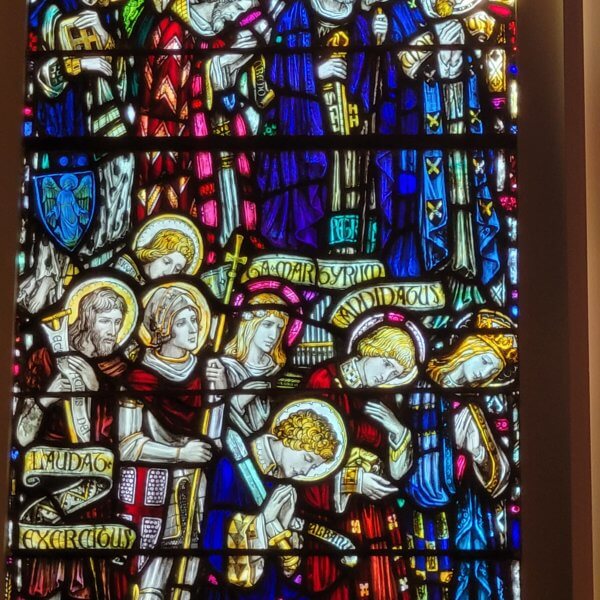
Blessedness
![]() We celebrate All Saints’ Day today with the Beatitudes from Matthew’s gospel. In the Episcopal Church, All Saints’ Day is one of the seven principal feasts of the church year, and one of the four days that we baptize new Christians. Why do we read the Beatitudes on All Saints’ Day? For a couple of reasons, right off the bat. First, being a saint is about being blessed, and the Beatitudes are all about blessedness — blessed are the poor in spirit, blessed are those who mourn, blessed are the meek. The saints are blessed — and the ones who go through the process of canonization are beatified, another form of the word. A saint is a holy person who shares life in Christ.
We celebrate All Saints’ Day today with the Beatitudes from Matthew’s gospel. In the Episcopal Church, All Saints’ Day is one of the seven principal feasts of the church year, and one of the four days that we baptize new Christians. Why do we read the Beatitudes on All Saints’ Day? For a couple of reasons, right off the bat. First, being a saint is about being blessed, and the Beatitudes are all about blessedness — blessed are the poor in spirit, blessed are those who mourn, blessed are the meek. The saints are blessed — and the ones who go through the process of canonization are beatified, another form of the word. A saint is a holy person who shares life in Christ.
In the Epistles, the Apostle Paul uses the word saint to mean all faithful Christians. And in the Episcopal Church, we celebrate saints known and unknown on All Saints’ Day, which gets at the idea in the New Testament that saints are all faithful Christians. When we read the Beatitudes, focusing on those who are blessed, we don’t read about deeds of power and wonder, extraordinary strength or heroism. Instead, those who are blessed are
the poor in spirit,
those who mourn,
the meek,
those who hunger and thirst for righteousness, [Notice there that the gospel does not say those who ARE righteous are blessed, but those who hunger and thirst for righteousness in the world are blessed.]
the merciful,
the pure in heart,
the peacemakers,
those who are persecuted for righteousness’ sake,
Being a saint
Being blessed — or just being a saint — is not about heroics. It’s about persevering. It’s about enduring. It’s about continuing to be merciful, to be peacemakers, and to hunger and thirst for righteousness, even when we are poor in spirit, even when we mourn, and even when we don’t feel like we’re up to the job.
 Think of Mary, mother of God. Many of us have connections to St. Mary, either as a name saint, for Roman Catholics, or if we have connections with a St. Mary’s Church. Mary, mother of God, Queen of Heaven, was not a likely saint. Mary was very young — one of the gospels not included in our final New Testament says that Mary was 16 years old, but many scholars say she was closer to 13. She was betrothed but unmarried, and not from a priestly family. She and Joseph were Jews under Roman occupation when Jesus was born in Bethlehem.
Think of Mary, mother of God. Many of us have connections to St. Mary, either as a name saint, for Roman Catholics, or if we have connections with a St. Mary’s Church. Mary, mother of God, Queen of Heaven, was not a likely saint. Mary was very young — one of the gospels not included in our final New Testament says that Mary was 16 years old, but many scholars say she was closer to 13. She was betrothed but unmarried, and not from a priestly family. She and Joseph were Jews under Roman occupation when Jesus was born in Bethlehem.
And while Mary enjoyed divine moments of maternal pride and love as she watched Jesus become a man — teaching, performing miracles, and healing — she also endured unimaginable mourning and surely loss of hope and poor spirit as she witnessed his imprisonment, torture, and crucifixion. In Renaissance art, Mary can be identified as Jesus’ mother in art through her gown — almost always painted in blue — and she also often wears a large pearl, with its white luster symbolizing her virginity and purity, and also her resilience and perseverance under unimaginable circumstances of loss and grief. The pearl became a symbol of Mary in Renaissance art.
The Pearl
 Maybe especially for Rhode Islanders, the pearl is a perfect image for a saint, and not just for Mother Mary, but also for ordinary saints, like you and me. We don’t farm pearls in Rhode Island as they do in Asia and in the South Sea, but we do know our oysters. And when we shuck our oysters, we occasionally find a pearl — maybe not of gem quality — but that may be another insight for us now. A pearl is formed from a grain of sand or other irritant in an oyster. The oyster soothes the irritation by coating it with concentric layers of nacre, smoothing and assimilating the irritant to create a pearl, a gem prized since ancient times.
Maybe especially for Rhode Islanders, the pearl is a perfect image for a saint, and not just for Mother Mary, but also for ordinary saints, like you and me. We don’t farm pearls in Rhode Island as they do in Asia and in the South Sea, but we do know our oysters. And when we shuck our oysters, we occasionally find a pearl — maybe not of gem quality — but that may be another insight for us now. A pearl is formed from a grain of sand or other irritant in an oyster. The oyster soothes the irritation by coating it with concentric layers of nacre, smoothing and assimilating the irritant to create a pearl, a gem prized since ancient times.
And this raises an interesting spiritual question: Can beauty emerge from conflict and suffering? Can grace come of kindness, tenderness, and empathy for the suffering of our neighbors? I have to believe that God knows it’s not easy to love God with all our heart, mind, soul, and strength, and love our neighbors as ourselves, or it wouldn’t be one of the Great Commandments. Saints are blessed because being a saint is hard work.
It’s the hard work of peacemaking, and of responding with pure-hearted mercy and a hunger and thirst for righteousness, even when we mourn and even when we’re discouraged. And we are discouraged now. The Israel-Hamas war, beginning with the unimaginable atrocity of Hamas’s attack on Israeli civilians, continues with the tragedy of thousands more innocent Palestinian deaths as Israel responds to Hamas’s existential threat to its existence with its own existential consequences. These consequences extend not only to Hamas, but also to innocent noncombatants — including thousands of children — who have lived under occupation by the State of Israel for 75 years.
The issues of security and occupation in the Holy Lands are long and complex. Just as the Palestinians live in an occupied state now, Israelites have endured as a people the cruelties of the Assyrians, slavery under the Egyptians, and exile in Babylon. Jesus’ entire living ministry was under the shadow of Roman occupation, which was both the context and content of his teaching. And the long shadow of the Holocaust hangs darkly over all of our understandings now.
I lived in Jerusalem for a year and came to know and love Israeli Jews and Palestinian Muslims and Christians there. I have been in close relationship and connection with my friends in Jerusalem since my return in 2019 when I came to you here at Emmanuel. And I can tell you that I emerged from that experience way less clear about who was right and what should happen next than I was when I took my first sip of fresh-pressed pomegranate juice in the Old City.
Peacemaking
 What and who does God call us to be in these times? I think God calls us to be oysters, filling the gaps between our perspectives and understandings with layer after layer of pearly nacre. How? God calls us to keep the Great Commandments: Love God with all your heart, mind, and soul, and love your neighbor as you love yourself. God calls us to dig deep, engage in the really hard work of being everyday, ordinary saints, and live out the Beatitudes. God calls us to do the hard work of peacemaking, and of responding with pure-hearted mercy and a hunger and thirst for righteousness. We can love one another, even as we mourn, and even as we are discouraged — offering kindness, mercy, empathy, and compassion to each and all who ache, which is pretty much all of us.
What and who does God call us to be in these times? I think God calls us to be oysters, filling the gaps between our perspectives and understandings with layer after layer of pearly nacre. How? God calls us to keep the Great Commandments: Love God with all your heart, mind, and soul, and love your neighbor as you love yourself. God calls us to dig deep, engage in the really hard work of being everyday, ordinary saints, and live out the Beatitudes. God calls us to do the hard work of peacemaking, and of responding with pure-hearted mercy and a hunger and thirst for righteousness. We can love one another, even as we mourn, and even as we are discouraged — offering kindness, mercy, empathy, and compassion to each and all who ache, which is pretty much all of us.
Saint Mary, the unwed teenage mother of God, a non-citizen in the Roman Empire who walked with her son through miracles, then imprisonment, crucifixion, and resurrection, could probably relate to that too. Grace can come of shared pain, love, and compassion. We can fill the gaps between our views, experiences, opinions and understandings — with relationship. That doesn’t mean that we magically come to a conformed perspective or a single opinion, but we do create bonds between us where we have actively loved one another — when it’s hard, when it’s uncomfortable, and when we disagree. God calls us to respond to these times with pure-hearted, peacemaking mercy, and a hunger and thirst for righteousness, even when we are poor in spirit, even when we mourn, and even when we feel like we’re not up to the job. Because it’s just what ordinary saints do. Amen
